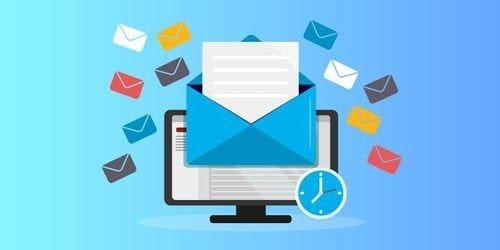Hey friend, ever fired off an email and felt that pang of disappointment when it bounced back? It’s like planning a surprise visit, only to find out your friend moved out ages ago! Bummer, right?
Well, in the email world, this “moving out” scenario is what we call email bounce rate, and it’s a metric that deserves our attention. If you’re serious about your email marketing game, understanding this little devil is crucial for success.
Let’s roll up our sleeves and get down to business.
What in the World is Email Bounce Rate and Why Should You Care?
Email bounce rate is essentially the percentage of emails that don’t make it to your intended recipient’s inbox. Think of it as undelivered mail piling up in the digital world.
Now, why should this matter to you? Imagine pouring your heart and soul into crafting the perfect email campaign, only for it to hit a wall of undelivered messages. Not only is it disheartening, but it can also wreak havoc on your sender reputation and torpedo your future email marketing efforts.
A high bounce rate is like a flashing red light, signaling that something’s amiss, and it’s time to investigate.

Decoding the Bounce: Hard vs. Soft
Before we jump into solutions, let’s break down the two main culprits behind email bounces: hard bounces and soft bounces.
Hard Bounces: The Permanent Roadblock
A hard bounce is like hitting a brick wall. It indicates a permanent delivery failure, meaning your email will never reach its destination. Common reasons for hard bounces include:
- Invalid email addresses: The email address simply doesn’t exist or has been deactivated.
- Non-existent domain: The domain name associated with the email address is invalid.
- Blocked sender: The recipient’s email server has blacklisted your email address or domain.
When you encounter a hard bounce, it’s best to remove that email address from your list ASAP. Sending repeated emails to a hard-bounced address is like banging your head against a wall—painful and unproductive!
Soft Bounces: A Temporary Hiccup
Soft bounces, on the other hand, are more like a detour—a temporary roadblock that might clear up eventually. They indicate a temporary delivery issue, often caused by:
- Full inbox: The recipient’s inbox is overflowing, and there’s no room for your email.
- Server issues: The recipient’s email server is down or experiencing technical difficulties.
- Message too large: Your email is too hefty for the recipient’s server to handle.
With soft bounces, there’s hope! The email might eventually get delivered once the temporary issue is resolved. However, if you see repeated soft bounces to the same address, it’s worth investigating further.
The Domino Effect: How Bounce Rate Impacts Email Deliverability
Now that we’ve demystified bounce types, let’s address the elephant in the room—how bounce rate affects your email deliverability.
Think of Internet Service Providers (ISPs) as the gatekeepers of the inbox. They use complex algorithms to filter out spam and ensure that only legitimate emails reach their users. And guess what plays a starring role in their judgment? You guessed it—bounce rate!
A high bounce rate raises red flags for ISPs. It suggests that you’re either sending emails to invalid addresses or engaging in spammy practices. This can lead to a cascade of negative consequences:
- Damaged Sender Reputation: ISPs use sender reputation as a measure of trustworthiness. A high bounce rate can severely tarnish your reputation, making it harder for your future emails to land in the inbox.
- Spam Folder Exile: ISPs might send your emails to the spam folder, where your intended audience is less likely to see them.
- Lower Email Delivery Rate: ISPs might start throttling your email delivery rate, delaying or even blocking your emails altogether.
In short, a high bounce rate can sabotage your email marketing efforts and make it feel like you’re shouting into a void.

Crunching the Numbers: Calculating Email Bounce Rate
Calculating your email bounce rate is a simple equation. Here’s the formula:
Bounce Rate = (Number of Bounced Emails / Total Number of Emails Sent) x 100
For example, if you send 5,000 emails and 100 bounce back, your bounce rate would be:
Bounce Rate = (100 / 5,000) x 100 = 2%
The Gold Standard: What’s a Good Email Bounce Rate?
While a 0% bounce rate would be a marketer’s dream, the reality is that bounces are inevitable. But don’t fret—a small number of bounces is perfectly normal. The key is to keep your bounce rate as low as possible.
So, what’s considered a healthy bounce rate? Industry experts generally agree that a bounce rate below 2% is a good target to aim for.
However, it’s important to note that bounce rates can vary depending on factors like industry, email type, and the quality of your email list. For example, a promotional email might have a slightly higher bounce rate than a transactional email.
Why Do Emails Bounce in the First Place?
Before we dive into the strategies for preventing bounces, let’s take a closer look at the common reasons behind these pesky delivery failures.
- Spam Filters on High Alert: ISPs use spam filters to weed out unwanted or suspicious emails. If your email triggers these filters, it’s likely to bounce back.
- Email List Hygiene Gone Wrong: An outdated or poorly maintained email list is a breeding ground for bounces. Invalid email addresses, inactive subscribers, and spam traps can all contribute to a high bounce rate.
- Email Server Woes: Technical issues on either the sending or receiving email server can also cause bounces.
- DNS Mishaps: Incorrect DNS records can prevent emails from reaching their intended destination.
Taming the Bounce Beast: 13 Proven Strategies for Lowering Your Bounce Rate
Ready to take control and reduce your email bounce rate? Here are 13 actionable strategies to implement:
1. Build Your Email List Like a Boss
Building a high-quality email list is the foundation of successful email marketing. Resist the temptation to buy email lists. They’re often riddled with invalid addresses and spam traps, which can lead to sky-high bounce rates.
Focus on organic list-building strategies like:
- Opt-in Forms: Use clear and concise opt-in forms on your website to capture interested subscribers.
- Lead Magnets: Offer valuable incentives, such as ebooks, checklists, or discounts, in exchange for email signups.
- Content Upgrades: Provide exclusive content related to your blog posts or articles as a bonus for subscribing.
2. Spring Clean Your Email List Regularly
An email list is like a garden—it needs regular weeding to thrive! Remove inactive subscribers, update outdated email addresses, and use email verification tools to identify and eliminate invalid addresses.
3. Double Opt-In: The Confirmation Power Move
Implement a double opt-in process to ensure that only genuinely interested subscribers join your list. When someone signs up, send a confirmation email requiring them to click a link to verify their subscription. This helps weed out typos and fake email addresses.
4. Partner with a Reputable Email Service Provider
Choosing the right email service provider (ESP) can significantly impact your email deliverability. Look for an ESP with a solid reputation, robust infrastructure, and features designed to optimize deliverability.
5. Warm Up Your IP Address
If you’re sending high volumes of emails, consider using a dedicated IP address. However, it’s crucial to warm up your IP address gradually to avoid triggering spam filters. Start by sending small batches of emails and slowly increase the volume over time.
6. Authenticate Your Emails Like a Pro
Implement email authentication protocols like SPF, DKIM, and DMARC to verify your sender identity and improve deliverability. These protocols help ISPs recognize your emails as legitimate and reduce the likelihood of them being flagged as spam.
7. Embrace the Power of Segmentation
Not all subscribers are created equal. Segment your email list based on factors like interests, demographics, and engagement levels. This allows you to tailor your content and send relevant emails that are more likely to be opened and clicked.
8. Personalize Your Emails
Personalization goes beyond simply addressing your subscribers by name. Use data you’ve collected to tailor your email content to their interests and preferences. Personalized emails are more engaging and less likely to be perceived as spam.
9. Craft Compelling Subject Lines
Your subject line is the first impression your email makes. It’s crucial to craft subject lines that are attention-grabbing, relevant, and avoid spam trigger words.
10. Optimize Your Email Content
Keep your email content concise, clear, and engaging. Avoid using excessive exclamation points, all caps, or spammy language. Focus on providing value to your subscribers and building relationships.
11. Test, Test, and Test Again!
A/B testing is your secret weapon for optimizing email campaigns. Test different subject lines, email layouts, and calls to action to see what resonates best with your audience.
12. Monitor Your Bounce Rate Like a Hawk
Regularly check your email bounce rate and investigate any spikes or unusual patterns. This allows you to identify and address potential issues before they impact your deliverability.
13. Develop a Solid Email Marketing Strategy
Don’t just send random emails—create a strategic plan that aligns with your business goals. A well-defined strategy will help you create targeted and effective email campaigns that engage your subscribers and minimize bounces.

Conclusion
Understanding and managing your email bounce rate is crucial for email marketing success. By implementing these strategies, you can reduce bounces, improve deliverability, and ensure your emails reach their intended audience. Remember, a low bounce rate is a sign of a healthy email list and a positive sender reputation, paving the way for greater engagement and better results.
FAQs
What are the most common reasons for hard bounces? Hard bounces typically occur due to invalid or non-existent email addresses, incorrect domain names, or sender blacklisting.
How can I identify and remove spam traps from my email list? Reputable email verification services can help identify and flag potential spam traps. Additionally, practicing good list hygiene and avoiding purchased lists can minimize the risk of spam traps.
Can I resend an email to a soft-bounced address? Your ESP might attempt to resend soft-bounced emails automatically. However, if you see repeated soft bounces to the same address, it’s best to investigate the cause and consider removing the address from your list if the issue persists.

